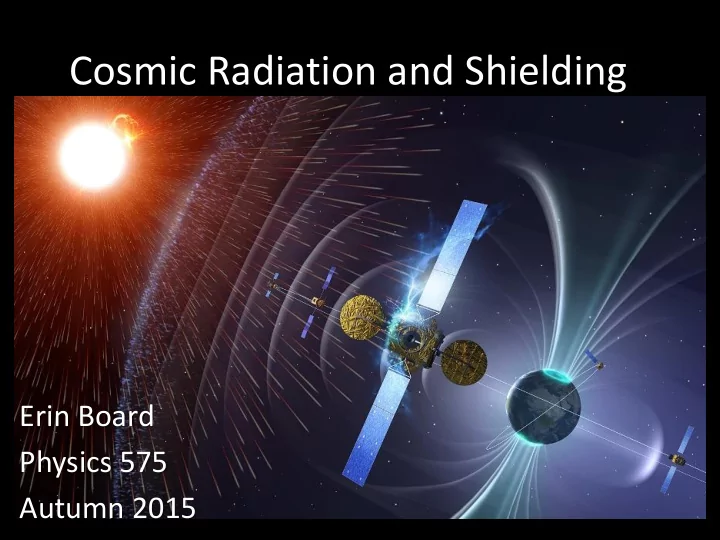

Cosmic Radiation and Shielding Erin Board Physics 575 Autumn 2015
Overview • What is Cosmic Radiation? • Health Effects • Detectors in Space • Shielding • Questions
Cosmic Radiation • High-energy protons and atomic nuclei • Originate from supernovae and solar events • Earth’s magnetic field and atmosphere provide shielding • Inflicts damage on electronics and living organisms
Health Effects • Astronauts on Apollo mission reported seeing flashes of light • Sufficient energy to change or break DNA molecules • Acute: diarrhea, nausea, vomiting, central nervous system damage, death • Long term: cataracts, cancer, sterility, mutated genes in offspring
ALTEA • The Anomalous Long Term Effects in Astronauts’ Central Nervous System • Astronauts on the ISS wore the helmet for 90 minutes during tests • 6 particle detectors measure the trajectory, energy, and type of particle passing through the brain • April 2006 – October 2007
PAMELA • The Payload for Antimatter Matter Exploration and Light-nuclei Astrophysics • Permanent magnet spectrometer • High precision and sensitivity • On board of a Russian satellite launched in 2006 • Circular orbit at 570 km (354 miles)
LRO • The Lunar Reconnaissance Orbiter carries 7 different instruments • The Cosmic Ray Telescope for the Effects of Radiation (CRaTER) characterizes the lunar radiation environment and biological impacts • Tests models of radiation effects and shielding • Launched in June of 2009 • LRO orbits the Moon at 50km (31 miles)
RAD • NASA’s Curiosity rover is equipped with a Radiation Assessment Detector • Preparation for human exploration • Measures and identifies all high-energy radiation at the surface of Mars • Uses a stack of silicon detectors and a crystal of cesium iodide • Small, lightweight, and energy efficient • Launched November of 2011 • Landed August of 2012
Results from RAD
Shielding Passive Active • Use a sufficient amount • Produce a magnetic field of material to absorb the that is big enough and energy from the cosmic strong enough to deflect radiation cosmic radiation
Passive Shielding • Cannot use materials of high atomic number • Problem: can generate secondary radiation • Best materials: liquid hydrogen, water, and polyethylene have high hydrogen count • Shield effectiveness drops as shield thickness increases
Passive Shielding • Provides only 130 to 175 days of protection depending on material • A mission to Mars would be approximately 200 days each direction • Passive shielding alone will not provide sufficient protection
Active Shielding • Recent breakthroughs with superconducting magnets make this more attainable • Smaller and lighter than normal magnets required to produce such a field • The Space Radiation Superconducting Shield (SR2S) project is working on a superconducting toroid magnet 10 m long and 12.8 m in diameter • Magnesium diboride superconducts at 10 Kelvin
Solution • Using both passive and active shielding together may provide the best protection for astronauts
Questions?
Recommend
More recommend